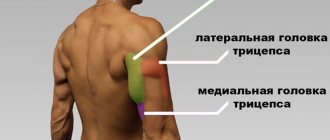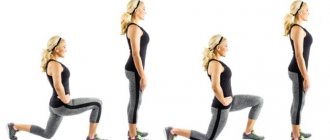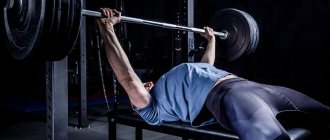Losing weight and getting stronger at the same time is the dream of many gym goers. The best way to burn calories is through intense exercise that gets your heart rate up and makes you sweat. Strength exercises are mostly aimed at muscle growth. However, there are those who can join the fat burning process with the right training and diet.
Let's figure out what strength exercises you should pay attention to in order to build muscle and burn fat.
Elena Skoblova
supervisor and master trainer of the World Class gym
If we talk about the most energy-consuming ones, then exercises with free weights are better suited, during which we involve the maximum number of muscle fibers in the work.
An exercise that will help you get stronger and lose weight. How and why to make thrusters?
How to replace an hour of running? 6 activities that will burn the same amount of calories
Deadlift
Technique:
- stand facing the bar, feet shoulder-width apart;
- bend your knees and grab the bar with your hands. At the same time, we move the pelvis back and move the shoulders forward. It is very important to keep your back straight and not bend;
- we straighten our knees and straighten up to our full height with the barbell in our hands. The upward movement begins from the head;
- the bar slides along the front surface of the legs.
Photo: istockphoto.com
How to combine training?
First, what not to do. Increasing the number of workouts and their duration while on a diet is a failed strategy. Recovery during an energy deficit is poorer, and trying to do more and more work explains why so many people end up in a state of severe overtraining and exhaustion. In general, too much training and too few calories is bad.
Hard training
The amount of training required to maintain muscles is much less than what is needed to grow them: it is enough to leave only a third of what you did before. But it is fundamentally important that the working weights remain the same. For example, to grow muscles, you worked out twice a week and at each workout you did 6 sets of 6-8 repetitions per muscle group. While losing weight, you can leave only 2 heavy sets of 6-8 repetitions while maintaining working weights and exercise once a week. Yes, just two heavy approaches.
If you train a muscle group once a week, you can simply reduce the number of approaches. If during training you did a total of 20-24 approaches per muscle group, 6-8 approaches on a diet will be enough. Instead of a 1.5-hour workout, you can do it in 30-40 minutes, depending on the warm-up and rest between sets. But, again, the weights should remain the same.
Metabolic training
As mentioned above, these workouts usually include everything high-repetition and with a short rest period. But it is important to remember that when you are on a diet, due to fatigue and lack of energy, exercise technique often suffers and injury can occur. Therefore, only people with very good technique can do “difficult”, complex movements quickly but safely. For others, exercise machines may be safer. The key is to keep rest intervals short.
Although the duration of the workouts will be short (20-40 minutes), they can be very tiring, which is expected. Metabolic training parameters:
- 2-4 approaches
- 15-20 reps
- 5-7 exercises
- Short rest intervals (60 seconds or less).
Seated dumbbell press
Technique:
- we sit on the bench, resting our backs against its back;
- We hold a dumbbell in each hand;
- raise the dumbbells to shoulder level;
- from this position we squeeze them up;
- then lower it back to the shoulders.
Photo: istockphoto.com
Elena:
We should not forget that weight loss will in any case depend not only on the choice of exercises for training, but in general on the volume and intensity of physical activity, activity during the day and diet.
Basic principles of home strength training for weight loss
Unlike cardio exercises, which are aimed at increasing endurance and working under long-term light loads, strength exercises increase the strength, volume and quality of muscle mass. To successfully lose weight while simultaneously forming a beautiful figure, you need to:
- Develop the maximum number of muscle groups. All muscles must be trained in a balanced manner to avoid overloading the musculoskeletal system, poor posture, and figure asymmetry. Giving preference only to those muscles in the area where the largest amount of fat is observed, you will not help reduce it only in this area.
- Get out of your comfort zone, regularly change the program, introducing new exercises. Manipulate the number of sets and repetitions to avoid the body adapting to the same loads. The more you like this or that exercise, the less effective it is.
- Use additional equipment and weights to develop muscles, using your own weight as much as possible.
- Focus on doing the exercise. Each exercise should be performed with maximum amplitude, and the weights should be selected in such a way that you can complete the prescribed number of repetitions to failure, but without pain.
- Restore. For weight loss purposes, 3-4 workouts per week with mandatory recovery periods are sufficient.
4th opinion: Exercises on “problem areas” burn fat!
This is true, but such exercises, by the way, work specifically on the muscles. Once activated, the muscles begin to more actively use the fat deposits surrounding them, receiving energy from the latter. In addition, their contractions literally displace fat and make fat cells flatter. That is why there is less fat, and cellulite loses its established positions. However, this process does not go quickly (which is not surprising, since you did not accumulate excess weight in three weeks, but over at least several years) and requires a responsible attitude: that is, exercise regularly and not haphazardly.
Types of fat burning workouts
Most often, fat-burning interval training refers to interval cardio. Running, jumping rope, jumping jacks, swimming, exercise bike, bicycle, elliptical, rowing machine, etc. are all great for successful weight loss. Just don’t forget that interval training includes 2 types of load – heavy and light. It’s also worth adding a few classic strength training sessions so that your muscles don’t fall apart during a calorie deficit. This is especially important for those who already have decent muscle mass. For beginners, it is permissible to simply use interval cardio to lose weight, and then gain weight using classical training.
Strength interval training is used less frequently, most often by girls and beginners - they are most suitable for them. Or when periodizing loads in experienced athletes.
Next, we will look at the main types of interval training for weight loss.
Interval running training
The simplest version of “intervals” can be performed at the stadium - this is the so-called interval running training for burning fat. You warm up, do a light stretch of the ligamentous-tendon apparatus. After this, you run a certain distance, alternating 10-30 second accelerations with intervals of measured running. With this option, it is important to remember that the time of quiet running should not be excessively long - no more than 2-3 minutes. It all depends on your level of preparation.
If you have nothing to measure time with, there is a simple way out - do intervals along the distance. For example, you have a classic 400-meter stadium. You need to run the straight section (about 100 m) at maximum, and then walk both turns and the second straight section, restoring your breathing. Over time, you can increase the lengths of fast running.
If there is no stadium near your home or you don’t like to run in open areas, then this is not a problem. The same running workout can be done in the gym on a treadmill. It is quite simple to adjust its speed and angle of elevation at intervals.
© Drobot Dean - stock.adobe.com
Interval workout training
Workout practitioners can be advised to alternate “explosive” pull-ups and/or push-ups with measured squats.
It may look like this: in 10-20 seconds, the maximum number of pull-ups is done with a clap; after jumping from the bar, the athlete proceeds to squats without weight, performing them measuredly, slowly for 30-60 seconds. After the last squat, a lying position is taken and the maximum number of push-ups is performed in 10-20 seconds. Next come squats again, and after them – pull-ups. And so on for 5-10 cycles. A static exercise, such as a plank, is also suitable as a “rest” period.
An excellent option for boxers would be to alternate between maximally intense jumping rope and periods of measured jumping for at least 10 minutes.
© Nadezhda — stock.adobe.com
Tabata Protocol
An interval training program for weight loss can also be based on the so-called “Tabata protocol”. It is named after the author, the Japanese scientist Izumi Tabata.
Initially, the system was used to train speed skaters. This is a form of extremely intense training. The point is to alternate exercises at a high tempo for 20 seconds (during which you need to perform about 30 repetitions) with a 10-second rest interval. After rest, intensive work begins again, then rest, etc. And so on for 4 minutes. This is followed by a short rest and a new segment of 4 minutes.
You can do the same movement, you can alternate 2 or more exercises, you can do something new each time. For beginners, exercises with your own weight are suitable - burpees, push-ups, squats, jump squats, pull-ups, parallel bars. Experienced athletes can choose exercises with additional weights. The selection conditions are simple: the involvement of a large muscle group and the ability to perform the exercise at high speed.
Workout with Cardio Equipment
If you're used to working out only at the gym, use the equipment available there, such as a bicycle and an elliptical, for interval cardio training.
Interval training on an elliptical trainer is very effective for weight loss. An example of such a workout: 5 minutes of warm-up, reaching 50-60% of the load of the maximum heart rate. Then alternate between 2 minutes of work at 50-60% of the maximum and 1 minute of work at 80-85%. Work for 20-30 minutes, and at the end do a five-minute cool-down at a fairly slow pace.
Straight twist
Lie on your back, bend your knees slightly and place your feet on the floor. Take the “pancake” from the bar with both hands and move it behind your head. Using your abdominal muscles, lift your shoulder blades off the floor, move your arms forward and hold the weight in front of you. Then smoothly return to the starting position. Perform the exercise one repetition at a count of 4/4 , 2/2, 3/1 - this will make one approach, do four of these.
If you have not done the Hot Iron program before, try doing all the exercises in this complex at a slow pace. After 2-3 workouts, when the technique is familiar to you, you can move on to training at an energetic pace.
General recommendations
Before you proceed, you need to familiarize yourself with the general recommendations, following which will protect you from injury and make your training more effective:
- Don't neglect warming up. It is very important, since its implementation will prepare your joints, ligaments and muscles for the main load.
- Choose the right weight . Heavy weight is not the key to success, because the most important thing in exercises is the correct technique, which is carried out by muscle effort. If the load is chosen incorrectly, you may only end up with a sprain or injury.
- Use athletic equipment such as a weightlifting belt and shoulder straps. They will protect your back and strengthen your grip on the barbell.
- Finish your workout with stretching. During exercise with a barbell, the muscles shorten, and stretching exercises will eliminate this effect, making your figure look more toned.
- To really get the results from your workouts, you need to stick to proper nutrition . Reduce the amount of carbohydrates and consume them before noon, avoid fatty and fried foods, and salty foods. Enrich your diet with vegetables, introduce fish and lean meat. Also follow the drinking regime. Drink about 1.5 -2 liters of water.
- Start with simpler exercises , do them slowly, mastering the technique. When your body is ready for heavy loads, incorporate more challenging activities into your workout.
Summing up
Both types of training have both pros and cons. Assuming that muscle maintenance is one of the main goals during a diet, "hard" training should be in the program. If you have to choose only one type, let it be this one. The exception is beginners, for whom any strength training is effective.
The volume and frequency of training should be reduced to a third to avoid overtraining. The fundamental condition is to maintain working weights. From a muscle maintenance standpoint, it's much better to do 2 quality heavy sets than 6 mediocre sets.
Metabolic training can be added to the “heavy” ones. The training program will depend on the individual, their ability to recover, their schedule, and their diet.
Hot Iron: Common Mistakes
They can nullify all your efforts. “The most common mistakes are in the technique of performing exercises, the choice of weight of the apparatus, the progression of weight and the complexity of performing elements. It is best to build an exercise program according to the principle “from simple to complex,” says Mikhail Bobrov.
In general, the Hot Iron training program involves classes in a group format under the supervision of a trainer. However, if you master the technique of doing the exercises well and select the working weights for yourself, you will be able to practice on your own.
Combination of aerobic and anaerobic exercise
For many, strictly counting seconds and tracking intervals while doing exercises is stressful and puts pressure on them. In this case, simply alternate between strength and cardio exercises at a pace that suits you. In order for the training program to be competent, it is better to contact a trainer who will help you create an individual program that is suitable for you.
Thanks to this, you will simultaneously build muscle mass and lose excess weight. As a result, active fat-burning workouts will help you get a sculpted, strong, lean and resilient body.
Half-hour classes at FitCurves include warm-up, strength and cardio exercise, cool-down and stretching. At the same time, you will receive individual support and advice on proper nutrition.
Interval training program in the gym
While in the gym, it would be stupid not to use the main weapon in the fight for quality muscles - the barbell and dumbbells. It is free weights that can create maximum stress on the muscles.
Interval training in the gym might look like this:
| Exercise name | Task, time/number of repetitions |
| Exercise bike | Warm-up – 5 minutes |
| Thrusters with a bar | 20-40 seconds as intensely as possible, 3 sets, 40-60 seconds rest between sets, during which we slowly walk around the gym |
| Dumbbell Bench Press | 20-40 seconds, 3 sets, rest 40-60 seconds between sets |
| Bent-over barbell row | 20-40 seconds, 3 sets, rest 40-60 seconds between sets |
| Front squats with barbell | 20-40 seconds, 3 sets, rest 40-60 seconds between sets |
| Treadmill, walking | Cool down – 5 minutes |
Attention: this program is not designed for beginners; experience in strength training and proper technique skills are required.
The moment with breathing is extremely important: throughout the entire program you cannot hold your breath and strain. You inhale at the moment of relaxation, exhale with effort.
Recipes for healthy eating
Oven fish and chips recipe
- 5.6 g Protein
- 2.9 g Fat
- 8.6 g Carbohydrates
- 75.5 kcal
50-60 min.
- #second course
- #mustard
- #dietary
- #baking
- #potato
- #honey
- #low calorie
- #dinner
- #vegetable oil
- #fish
- #spices
- #dinner
Other recipes











